Last Saturday was another monthly Piano Party day for my students!
As we waited for everyone to arrive, the students competed two worksheets: a lines vs. spaces worksheet from Fun & Learn Music, and an intervals worksheet from my Printables page.
I always have students go around the room to introduce themselves, just in case they’ve forgotten each other’s names and so they can learn the names of any new students. I like to have them share fun facts about themselves along with their name, so it doesn’t get too serious. 🙂 This time, I had them share their favorite flavor of ice cream.
Our first game was called, “Floor Staff Race.” It is based on this game I read about at pianimation.com, but instead of using “Step/Skip” and “Up/Down” cards, I decided to make dice. Here’s how the game works:
Each student chooses a beanie animal. The goal is to race from the bottom of the staff to the top of the staff. On their turn, they roll the dice and follow the directions to go either up/down by a 2nd/3rd. Whoever reaches to top of the staff first is the winner!
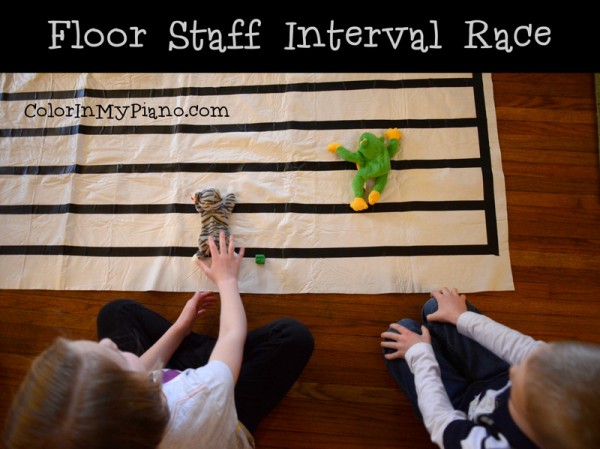
For the dice, you can use foam or wooden cubes from a craft store. I wanted the chances of going UP on the staff greater than the chances of going DOWN (otherwise the game would never end!), so here is a listing of what I wrote on the six sides:
- UP a 2nd
- UP a 2nd
- UP a 3rd
- UP a 3rd
- DOWN a 2nd
- DOWN a 3rd
I grouped my students into pairs (I had made 4 dice), and gave them each a section of my floor staff for their race.
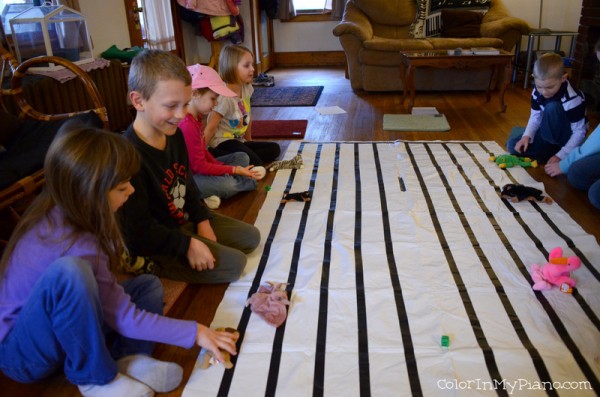
They loved this game!
Next, we had a performance class where students could play their recital piece in progress (our Spring Recital is scheduled for March 30th). I like to give students something to pay attention to as they listen (especially with all the young beginners I have). In the past, I’ve used dry erase listening sheets but I decided to try something a little different this time: the Listening Race Cards from pianimation.com. I didn’t use the cards exactly as intended for Jennifer’s game this time (but I do plan to use them as intended sometime in the future). Instead, I handed out a category of the cards (dynamics, tempo, emotion, touch, tonality, meter) to each pair of students. After we heard each recital piece, I went around the room to see if each pair was able to choose the right card(s) from their category. My students liked working together to find the right card to match the music! I’ll definitely be doing this again.
Remember the DIY Music Whiteboard I posted about last week?
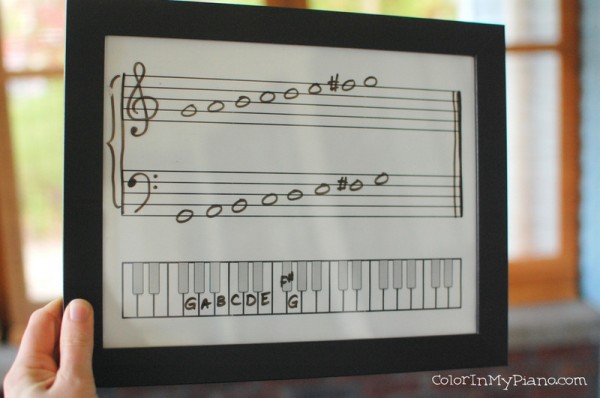
Well, I did manage to come up with a good group game for the whiteboards! I call it “Whiteboard Music Trivia.” I divided my students into two teams. Each time I asked a question, the teams worked together to come up with the right answer to write on their whiteboard. The first team to hold up their whiteboard with the correct answer earned a point.
Here is a quick sampling of the kinds of questions I asked:
- On the staff, draw the note D in the treble clef.
- Write the English word for forte.
- On the staff, write out the 5 notes of the C major 5-finger pattern, ascending only.
- Mark a D on the keyboard.
- Draw a treble clef.
As I was planning for this game, I realized that it might be challenging to keep track of which questions I had already asked throughout the game. So, I typed up a quick checklist of some good questions, so I could mark off the questions as I asked them. I’ve uploaded the free checklist on the Printables > Games page, under “Whiteboard Music Trivia.”
Next, I pulled out an old favorite: the Team Rhythm Dictation game. The game is described in detail here in this post about the first-ever Piano Party I tried with my students in April of 2012 — but basically, the team members work together to properly notate a rhythm which I clap for them. More info about the free Rhythm Value cards is here.
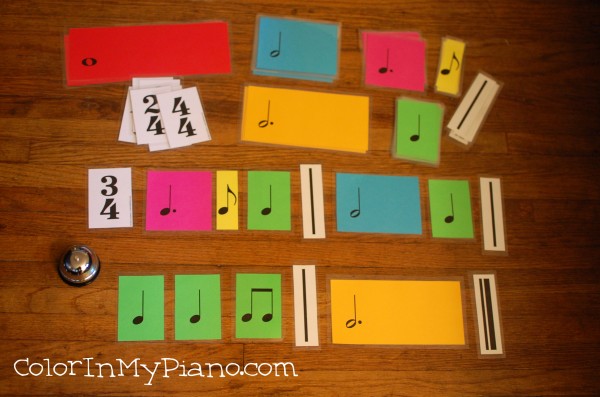
In the past, I have always clapped rhythms that I made up on-the-spot. To do that, though, I had to be careful to remember the rhythm exactly and not accidentally alter the rhythm when the teams need to hear it again! To prevent that from happening this time, I decided to use rhythms from my set of Level 1 Rhythm Cards ($6 in the shop). Those cards been useful for so many different activities!
I always try to end the Piano Party with a game that is still playable even as students begin to leave with their parents. This time, I chose the Adventures in Music board game.
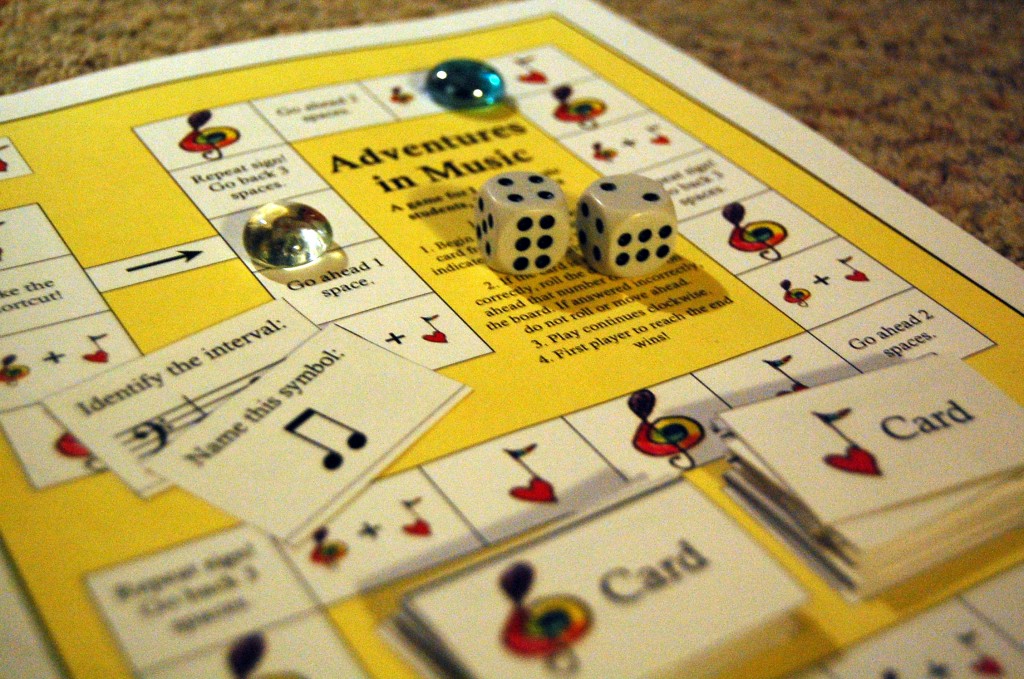
This game quizzes students on a variety of terms and skills (like note naming and interval identification).
And that concluded our March Piano Party!


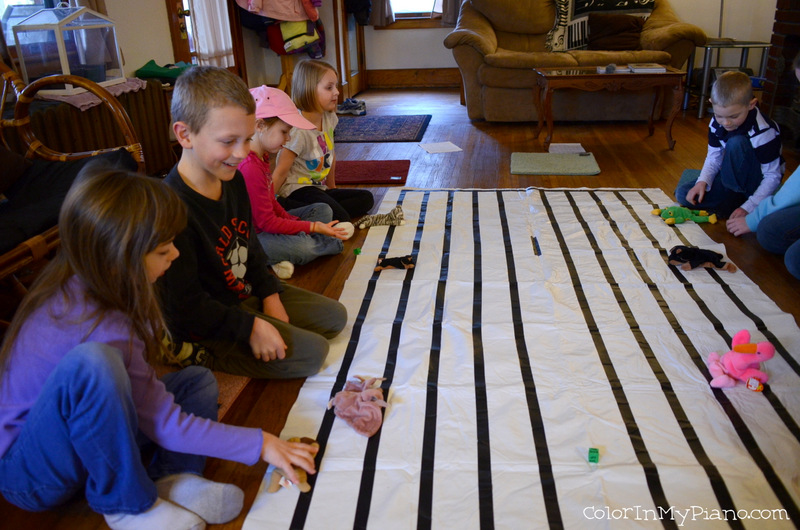
How much time do you schedule for your monthly piano parties? It seems like an hour would be a little too short, but two hours would be too long.
You guessed correctly! I hold them for an hour-and-a-half.
Hi Joy,
Thanks for the mention of all of my games. It’s always fun to see pictures of students from other studios using them! I like the idea of the dice for the floor staff, and I LOVE the staff whiteboard you made!!
Thank YOU, Jen! 🙂 Your games have been such a hit with my students!
What a fun party! Can’t wait to try the floor staff race with the beanie animals…my kids will love it!
Dear Joy,
Thank you so much for sharing the wonderful ideas and activities that you have been doing with your students!! I am so inspired and hope to hold a party like this too during the term break.
But my questions are:
1) what should I do with the students that have very different levels? do you split them into two different days of party?
2) how about those new beginners who haven’t even learned the staff?
Appreciate your input. Thank you!
Regards,
Veon
Right now, Piano Parties are for all my students under age 15, and they all come at the same time. They are mostly beginners and elementary students, plus two early-intermediate students. If you have a lot of students or if you wish to be able to focus on a particular skill, you may wish to separate it into two separate groups. I am careful to choose games and activities that will work across the range of skills I have. Remember, you don’t necessarily have to teach new concepts. To me, Piano Parties are more about reviewing concepts in perhaps a new way, and in a group setting. I do have some students who have only recently learned the staff, but I have still been able to find activities that work for everybody. You can browse some of my previous posts about these Piano Parties to see some examples of games I’ve used in the past. Good luck, Veon!
So…do they come for regular lessons during the week and then you have an extra theory party on Saturday? Or do you just do the piano parties and that is their lesson for the week? Thank you so much for your insight and ideas. You have been a huge help in setting up my studio!
Yes, my students have their regular lessons during the week and then come for a group class on Saturday. It has worked great for me, especially when my studio was small after I first moved to my current town. My piano parties are starting to get larger now, so I may have to split it into two classes at some point!